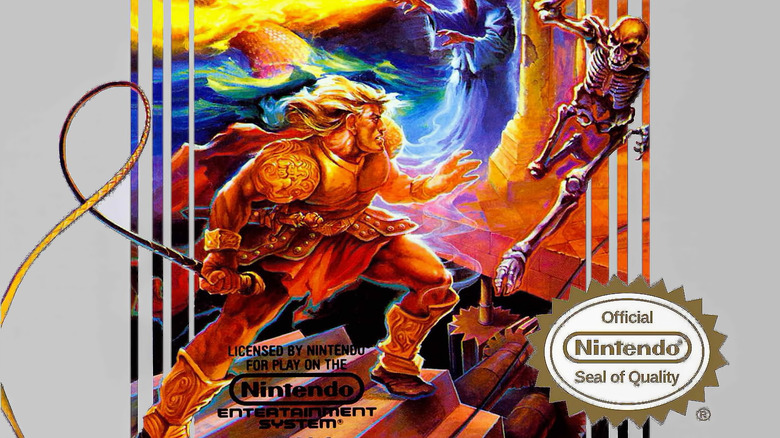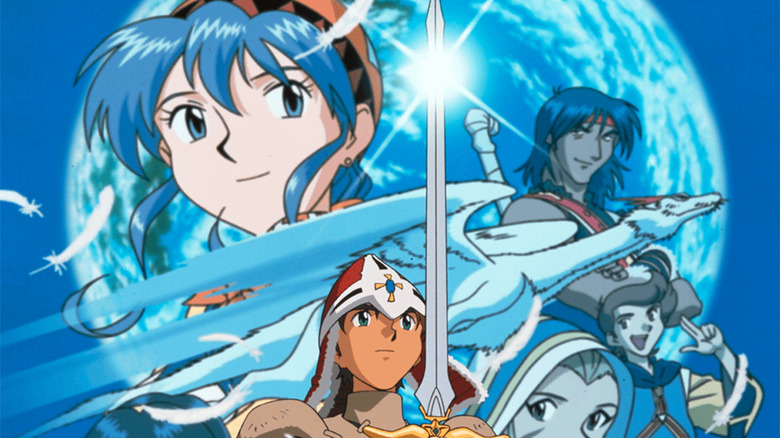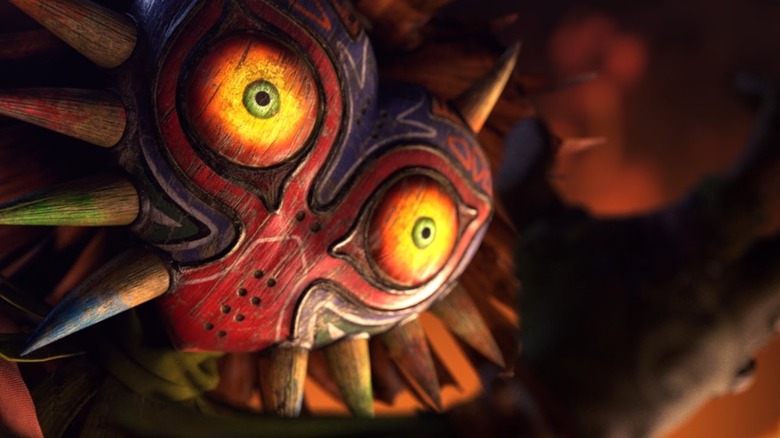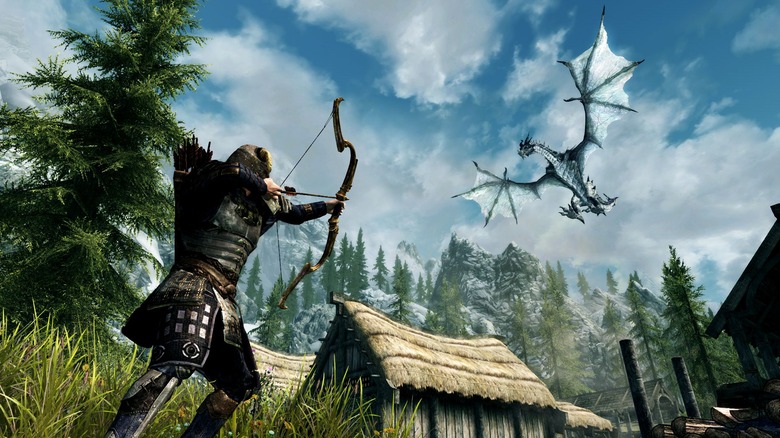The Most Popular Game Released The Year You Were Born
After video games transitioned from the arcade to the living room in the 1980s, they became a huge part of our lives. As this new form of entertainment began to catch on, Nintendo and Sega fought to come out on top with players, sparking a fierce era of "console wars." Later, the video game market fractured even further, with the introduction of handheld systems and new consoles like the PlayStation and Xbox.
Because of the way video game releases are staggered, it might take a year (or even more!) before a game is available worldwide. Even avid gamers might be surprised to learn the year some of their favorite video games came out. By using IMDb's top-rated video game charts and looking at the most popular games with more than 100 votes, we've come up with a list showcasing the hottest console video games of every year since 1984. So take a trip down memory lane with us to find out the most popular video game released the year you were born.
1985 - Super Mario Bros. (NES)
Although Mario had previously appeared in the arcade games Donkey Kong (1981) and Mario Bros. (1983), this powerful little plumber became famous around the world after Nintendo gave him his own NES game. The side-scrolling platformer Super Mario Bros. was released in 1985, launching one of the most popular video game franchises of all time.
Developed by Shigeru Miyamoto as a send-off for the Japanese Famicom system, Super Mario Bros. actually shares some DNA with The Legend of Zelda, which was created by Miyamoto at the same time. The rotating bars of fire that Mario frequently encounters in castles were an unused design element leftover from The Legend of Zelda. In the United States, Super Mario Bros. was bundled with the newly-launched Nintendo Entertainment System, and the extremely popular console and game helped revive the flagging video game industry after the market crash of 1983.
1986 - The Legend of Zelda (NES)
In 1986, Nintendo followed up the massive success of Super Mario Bros. with yet another video game blockbuster — The Legend of Zelda. This nonlinear fantasy adventure became an instant success in Japan on the new Famicom Disk System, and the shiny gold cartridge proved to be just as popular in Europe and North America on the NES. The Legend of Zelda appealed to gamers around the world and gave Nintendo another exclusive flagship franchise to add to their collection.
Both Super Mario Bros. and The Legend of Zelda featured a number of unique innovations that greatly influenced the future of the video game industry. Nintendo hired composer Koji Kondo to design the music and sounds for both games, and Kondo's iconic scores inspired other developers to make music a more important and integral part of the gameplay experience. Additionally, The Legend of Zelda had a new feature that forever changed the way we played video games: it was the first home console cartridge to include an internal battery, which allowed players to actually save their progress.
Honorable mention: Also in 1986, Nintendo introduced players to space-age bounty hunter Samus Aran with their classic action-adventure game Metroid.
1987 - Mike Tyson's Punch-Out!! (NES)
After earning widespread praise for their arcade games Punch-Out!! and Super Punch-Out!!, Nintendo made the smart move to port their boxing franchise to the Nintendo Entertainment System in 1987. For this new version, Nintendo blended elements from both arcade titles and added several features to help set the game apart from its predecessors. These upgrades included animated cutscenes, a password-backed saving system, and a soundtrack featuring the extremely catchy "Look Sharp, Be Sharp" march — a famous jingle used by the Gillette razor company in the 1950s.
The new game also got a new cast of characters, too, including the up-and-coming professional boxer Mike Tyson. After watching Tyson fight in a bout, Nintendo of America founder Minoru Arakawa wanted to put him in the game. Nintendo reportedly gave Tyson $50,000 for a three-year contract to use his name and likeness — which paid off when Tyson won the WBC heavyweight championship in late 1986. In 1987, Nintendo released Mike Tyson's Punch-Out!! for the Famicom and NES, which became an instant hit with gamers around the world.
1988 - Super Mario Bros. 3 (NES)
Nintendo continued their hot streak in 1988 with the release of Super Mario Bros. 3. The game's North American NES release was delayed by almost two years because of a computer chip shortage, but the 1989 movie The Wizard (which featured child star Fred Savage playing the unreleased game) helped to drive sales when it finally hit U.S. shelves in 1990. Super Mario Bros. 3 ended up becoming one of the most-beloved Nintendo games of all time.
Developed by the same team that created Nintendo's earlier Mario titles, Super Mario Bros. 3 stays true to its roots while also adding several new innovations to Mario's gameplay. Like the original Super Mario Bros., this game made use of some elements originally created for the Zelda series. The "Chain Chomp" enemies in Super Mario Bros. 3 were actually inspired by some unused concept art created for The Legend of Zelda. The game introduced several new power-up items like the Super Leaf and Frog Suit, and added new abilities like sliding, climbing, and picking up blocks to Mario's arsenal. These features and the new overworld map introduced in Super Mario Bros. 3 later became mainstays of the franchise.
1989 - Castlevania III: Dracula's Curse (NES)
The third entry in Konami's legendary Castlevania series was both a bold new direction and a return to its roots. On one hand, Castlevania III: Dracula's Curse eschewed the RPG elements of its predecessor in favor of the side-scrolling platforming of the original. On the other, Castlevania III featured branching paths, which affected the levels the player fought through as well as which endings he or she might achieve. In addition, this is the game that introduced playable side characters to the franchise, opening up the potential for different gameplay styles. In terms of the narrative, this is where Dracula's son Alucard — which is just "Dracula" spelled backwards — first made his debut. An important game for one of the era's most important franchises, then, and the standout release of 1989.
Honorable mention: Although it was first released in 1984 for PC, the Russian-made puzzle game Tetris gained a much bigger following in 1989 when Nintendo bundled it with their new Game Boy handheld system.
1990 - Super Mario World (SNES)
Mario may have been upstaged by Final Fight and Tetris in 1989, but he made a comeback in 1990 when Nintendo released Super Mario World as a launch title for their new 16-bit Super Nintendo Entertainment System. The side-scrolling platformer closely resembled earlier Mario games, but it also added several new features, characters, and design elements. This was the first Mario game to feature the "Cape Feather" flying power-up, as well as the ability to "store" an extra power-up in a box at the top of the screen. Additionally, Super Mario World added in lots of secret routes for players to unlock, which definitely added to the replay value of the game.
Most importantly, Super Mario World introduced players to the dinosaur Yoshi, who serves as a companion that Mario can ride through most of the levels. Yoshi's unique skills let him eat some of Mario's enemies, stomp on others, and use colored Koopa shells to gain additional temporary attacks and abilities. Super Mario World proved to be extremely popular, with many considering it to be one of the best video games of all time.
1991 - The Legend of Zelda: A Link to the Past (SNES)
Mario came out on top with Super Mario World in 1990, but he was upstaged again in 1991 when Nintendo released The Legend of Zelda: A Link to the Past for the SNES. This fantasy action-adventure is the third installment in the wildly popular Zelda series, and it abandoned the side-scrolling elements seen in 1987's Zelda II: The Adventure of Link, taking a ¾ top-down perspective like the original The Legend of Zelda. For A Link to the Past, Nintendo added several new elements to the gameplay (like the Master Sword and parallel worlds) which went on to become hallmarks of the franchise. The game blended RPG elements with real-time fighting and nonlinear exploration, which proved to be an extremely popular combination with gamers.
Super Mario World would probably sit atop the polls in most "best of" video game rankings if it weren't for A Link to the Past, which is seen by many today as the pinnacle of the Zelda franchise.
1992 - Lunar: The Silver Star (Sega CD)
In the early '90s, the writing was on the wall for the venerable old cartridge. There was, literally, a shiny new object on the way: the compact disc, or CD. Sega jumped on board this new medium early by developing the Sega CD add-on for their Genesis console. CDs allowed for more data, and therefore much bigger and higher-quality games. An early standout of this new era was Lunar: The Silver Star, which included groundbreaking features such as voice acting and full-motion video, which consoles could previously only dream about. Developer Game Arts parlayed that technical capacity into artistic gold by filling the game with rich art and a compelling story, brought to life by brilliant animations and deeply drawn characters. Lunar was very much a precursor to the coming JRPG boom that would arrive later in the '90s, and it remains a beloved classic.
Honorable mention: 1992 was a great year for gaming all around, as it also featured the release of platforming classic Sonic the Hedgehog 2 and racing behemoth Super Mario Kart, either of which could have taken the top spot easily.
1993 - Super Mario All-Stars (SNES)
Although Sega took the top honors in 1992, Nintendo bounced back in 1993 with the SNES compilation Super Mario All-Stars. This game features remakes of all three original Nintendo Entertainment System Super Mario Bros. games as well as The Lost Levels, a Japan-only Famicom game. In 1994, the compilation was expanded to include 1990's Super Mario World and bundled with the Super Nintendo. Super Mario All-Stars enhances the original NES Mario games for the 16-bit SNES with 256-color graphics and updated soundtracks. Super Mario All-Stars also added the ability to save your progress to all the NES titles, which let players take their time on playthroughs and switch between games whenever they wanted. This new save feature in All-Stars was a game-changer, especially for players who remember losing hours of progress when their little brother "accidentally" pushed the reset button on the NES. If you could only own one Mario game, it'd probably have to be Super Mario All-Stars.
Honorable mention: 1993 was a particularly good year for Nintendo, and they made sure to have some awesome options for gamers suffering from Mario fatigue — like the gorgeous RPG Secret of Mana for SNES and the action platformer Kirby's Adventure for NES.
1994 - Super Metroid (SNES)
For years after its release, gamers had been clamoring for a follow-up to 1986's Metroid. They finally got their wish in 1994, when Nintendo released Super Metroid for the 16-bit SNES. This third installment in the sci-fi franchise features bounty hunter Samus Aran facing off with the evil Space Pirates on their home turf. Super Metroid retains the side-scrolling gameplay of its predecessors, adding some new features that went on to become mainstays of the series. Most notably, Super Metroid was the first title in the franchise to include automatic mapping and an inventory screen. Samus and her power suit got an upgrade too, including the Grapple Beam and the ability to shoot in any direction while moving. Super Metroid took lead producer Yoshio Sakamoto and his team over two years to make, but it was definitely worth the wait. With crisp graphics, engaging and perfectly paced levels, and an edgy and atmospheric soundtrack, Super Metroid may just be the best action adventure game of all time.
Honorable mention: Although nothing could top Super Metroid, a couple of other 1994 releases came close. Platformer addicts hailed the 3D adventure Donkey Kong Country, while RPG fans had two games to celebrate: EarthBound and Final Fantasy VI.
1995 - Chrono Trigger (SNES)
In 1995, the title of most popular game belonged to Chrono Trigger, a fantasy/action RPG developed by Square for the SNES. Square's Chrono Trigger design team included several prominent game creators, like Yuji Horii (Dragon Quest), Hironobu Sakaguchi (Final Fantasy), and Dragon Ball manga artist Akira Toriyama. With such an impressive pedigree, gamers had high expectations — and Chrono Trigger delivered. If RPG fans were happy with 1994's EarthBound and Final Fantasy VI, they were positively ecstatic over Chrono Trigger.
Set in a world where all eras of history exist simultaneously, players use time travel extensively to complete their quest. Actions made in the past affect the future, sometimes in quite unexpected ways. These different timelines and numerous side-quests offer plenty of character development opportunities — and an astounding 13 unique endings. The Final Fantasy-like battle system also introduced a cooperative aspect that allows players to coordinate attacks. These revolutionary new innovations from Chrono Trigger later became staples of game design, but they sent a shockwave through the gaming world back in 1995. Paired with a memorable story, gorgeous graphics, and a sweeping soundtrack, Chrono Trigger earned its place as one of the best RPGs of all time.
1996 - Super Mario 64 (N64)
In 1996, Mario returned to the forefront of video gaming with Super Mario 64 — and this was Mario as we'd never seen him before. Nintendo used Super Mario 64 to launch the Nintendo 64 console, and it definitely showed off the capabilities of the new system. While gamers had seen 3D sprites in Nintendo games before, like those used in 1994's Donkey Kong Country, they'd never experienced anything like three-dimensional graphics in Super Mario 64.
In the game, Mario uses magical portals within Princess Peach's castle to travel to other worlds and collect the Power Stars he needs to set the Princess free and defeat Bowser. While the plot was fairly typical of a Mario title, the gameplay was anything but. Super Mario 64 features a go-anywhere style of 3D exploration, and Mario's regular arsenal of moves expanded vastly to include wall-jumping, ground-pounding, and even sneaking around enemies. These changes and the 360-degree control provided by the N64's analog stick gave players an unprecedented amount of freedom, revolutionizing the platform game genre forever.
Honorable mention: Also in 1996, Nintendo took a chance on a unique new game concept, releasing Pokemon Red/Green/Blue for the Game Boy and launching a multimedia franchise that is still wildly popular more than two decades later.
1997 - Final Fantasy VII (PlayStation)
Powerhouse game developers Square took the crown again in 1997 with Final Fantasy VII for the Sony PlayStation. This landmark RPG was originally planned for the Super Famicom/SNES, but Square delayed production to finish Chrono Trigger — later deciding to make FF7 their first 3D title in the series. After experiments showed that the Nintendo 64 couldn't handle what they had in mind, Square transitioned to the CD-based PlayStation. The capabilities of Sony's console let the design team really go wild, giving FF7 a graphically-intense and cinematic style that would come to define the franchise.
Those upgrades weren't cheap, though — Square CEO Tomoyuki Takechi estimates they spent $40 million on development alone, and another $40 million on the game's marketing. Final Fantasy VII raised the bar and redefined the genre with its mind-blowing graphics and in-depth narrative. Not only did FF7 almost single-handedly popularize the PlayStation and Japanese-style RPGs in the West, it also contains one of the most shocking plot twists in video gaming history — one that gamers are still talking about today.
Honorable mention: Nothing can really compare to FF7, but we definitely can't forget two other landmark titles from 1997: Goldeneye 007 (N64) and Castlevania: Symphony of the Night (PlayStation).
1998 - Metal Gear Solid (PlayStation)
Although Nintendo had solidly dominated video gaming since the early '80s, new player Sony began making major inroads with the success of the PlayStation and games like Gran Turismo, Final Fantasy VII, and Castlevania: Symphony of the Night. Sony came out on top again in 1998 with the help of Konami and their stealth action-adventure game, Metal Gear Solid. Advertised as a game chock-full of "tactical espionage action," MGS follows the story of Solid Snake, a soldier tasked with infiltrating a terrorist base and stopping the bad guys before they can launch a nuclear strike. The realistic gameplay and exciting plot of Metal Gear Solid are further enhanced by the PlayStation's hardware capabilities and the wide variety of weapons and skills, which allow players to complete the game using any method they prefer. The intense action and unconventional gameplay of Metal Gear Solid helped popularize the stealth genre, spawning numerous sequels and influencing a host of later stealth franchises like Hitman, Deus Ex, and many others.
Honorable mention: Sony may have earned the top spot this year, but it was a tight race thanks to Nintendo's extremely popular new N64 title, The Legend of Zelda: Ocarina of Time.
1999 - Shenmue (Dreamcast)
Sega made a series of major business mistakes in the '90s, leaving the company's future in jeopardy. These issues came to a head after they cancelled plans for a 3D Sonic game and their Sega Saturn console flopped. Sega made one last attempt to get back in the game, releasing the new Sega Dreamcast system. In 1999, Sega pulled out all the stops, spending at least $47 million to develop and market their new action-adventure Dreamcast game Shenmue. This epic 4-disk game really showed off what the Dreamcast was capable of, combining martial arts and brawler elements with a dazzlingly detailed open world that allows players to explore to an extent never seen before in console games. Players can talk with hundreds of unique characters and interact with nearly everything in the environment around them as they guide Ryo Hazuki on his quest to find his father's murderer. Shenmue also featured a day/night cycle and weather system, making for an unprecedented amount of realism in the game's immersive world.
Honorable mention: Shenmue might be the most popular game of 1999, but Sony and Nintendo both released several classics that year, including Silent Hill, Super Smash Bros., Pokémon Gold/Silver, and Final Fantasy VIII.
2000 - The Legend of Zelda: Majora's Mask (N64)
How do you follow up The Legend of Zelda: Ocarina of Time, one of the best-loved entries in one of the entire medium's best-loved series? It's not easy. But then again, this is Shigeru Miyamoto we're talking about, and the man can do no wrong (well, except sometimes). He and his team knocked it out of the park (again) with their follow-up, The Legend of Zelda: Majora's Mask. Weaving together the time-shifting elements of previous installments with a much grimmer plot, Majora's Mask is a more mature and yet still perfectly family-friendly addition to Nintendo's lineup. Standout features include the various masks that hero Link dons to become creatures with different abilities, and the repeating three-day loop upon which the entire premise is based. The Nintendo 64 was already getting a bit long in the tooth at this point, but games like Majora's Mask proved the system still had plenty of life left in it.
Honorable mention: The end of the millennium offered a slew of amazing titles, including Perfect Dark on the N64 and Final Fantasy IX and Spyro: Year of the Dragon for the PlayStation.
And the rest ...
The turn of the millennium marked the end for Sega, and major changes in the console industry. With the release of the PlayStation 2 and the Xbox, Sony and Microsoft rose to prominence. Smartphones got smarter, and mobile gaming became widespread. Gamers were getting older, and their preferences changed largely to multi-platform games, especially open-world survival, adventure, and shooter franchises.
According to IMDb's users, here's the list of the best console games of 2001 to 2017, which does not include any re-releases, mods, DLC, expansions, or mobile games: Silent Hill 2 (2001), Kingdom Hearts (2002), Star Wars: Knights of the Old Republic (2003), Metal Gear Solid 3: Snake Eater (2004), Kingdom Hearts II (2005), Shin Megami Tensei: Persona 3 (2006), God of War II (2007), Metal Gear Solid 4: Guns of the Patriots (2008), Uncharted 2: Among Thieves (2009), Mass Effect 2 (2010), The Elder Scrolls V: Skyrim (2011), Fire Emblem Awakening (2012), The Last of Us (2013), South Park: The Stick of Truth (2014), The Witcher III: Wild Hunt (2015), Uncharted 4: A Thief's End (2016), and The Legend of Zelda: Breath of the Wild (2017).




